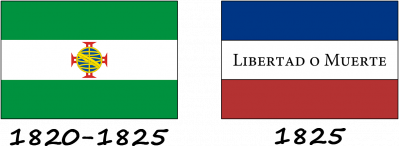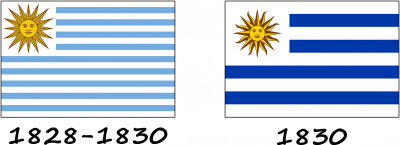The Viceroyalty of the Rio de la Plata, created in 1776, was part of the Viceroyalty of Peru, which simplified the management of Spanish-dependent territories in South America. However, it did not last long and was created at the beginning of the struggle for independence in Latin America. Uruguay, formerly called the Eastern Province, was one of the provinces of the Viceroyalty of Rio de la Plata and had the same flag as the official one.
The Spaniards arrived in Uruguay as early as 1516, but a significant role in the country's history was played by the Portuguese, who arrived a little later. Montevideo, the capital of the viceroyalty, was occupied by the British during the Napoleonic Wars that preceded Uruguay's independence. Despite the strong regional identity of the inhabitants of the Eastern Province, their influence in the viceroyalty was less significant than in Buenos Aires.

After the May Revolution of 1810, the government and people of the United Provinces of the Rio de la Plata formed a union of all the states of the Viceroyalty of La Plata to become independent of Spanish rule. The white and blue two-striped flag of the time was designed by Manuel Belgrano and was the predecessor of the modern Argentine flag. However, Paraguay, Uruguay, and Bolivia chose a different path to independence and seceded from the United Provinces. The Federal League, created by José Artigas, was a regional confederation within the United Provinces of the Rio de la Plata, and its official flag was the Artigas flag, with a white stripe in the center and three blue-red-blue stripes above and below it. The League included the territory of modern Uruguay and other small Argentine provinces. Today, the Artigas flag is the national symbol of Uruguay and is considered the forerunner of Uruguay's independence from the United Provinces. The Artigas is considered a symbol of Uruguay and the progenitor of federalism in both countries.

The province of Cisplatina, located in the east of Brazil, was under Portuguese and Brazilian occupation from 1823 to 1825. The annexation of the entire eastern territory to Brazil led to the independence of Uruguay, when Brazilians declared themselves an independent nation. In the early years of Brazil's existence as an autonomous state, the Uruguayan territory was under its rule. The flag of the province of Cisplatina consisted of a pair of green and white stripes with the kingdom's coat of arms in the center. The Uruguayan Resistance, known as Los Treintas and Tres Orientales, was a group that fought for Uruguayan independence from Portugal, Brazil, and Agrave. The flag of the Resistance consisted of three stripes - blue, white and red - and the inscription "Freedom or Death". The flag was used by revolutionary troops in battles against the kingdom and even Brazil.

On August 28, 1828, the Preliminary Peace Convention was signed, which certified the creation of an independent state on the territory of the Eastern Banda. This became the basis for the birth of Uruguay as an independent country, separate from Argentina and Brazil. At a meeting in Villa Guadalupe, the interim governor Joaquín Suárez declared the need to create his own national flag, as the flag of the United Provinces of the Rio de la Plata had been used until then. Therefore, on December 16, 1828, a law was passed to create the national flag of Uruguay, which established that the national flag would be white with nine alternating horizontal blue stripes and a white square in the upper corner on the side of the pole, in which the sun would be placed. The nine blue stripes represented the departments into which the territory of Uruguay was divided at the time: Canelones, Cerro Largo, Colonia, Durasno, Maldonado, Montevideo, Paysandú, San José and Soriano.
On July 12, 1830, the flag was changed. The meaning of the symbols remained the same, but now it had 9 stripes according to the departments of Uruguay: Montevideo, Maldonado, Canelones, San Jose, Colonia, Soriano, Paysandu, Durasno and Cerro Largo.





